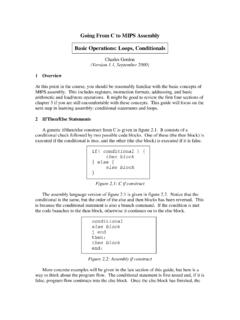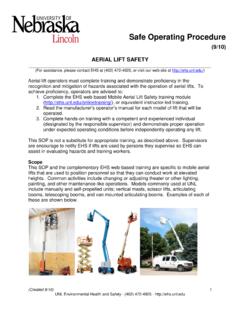Transcription of THE BASICS OF PARLIAMENTARY PROCEDURE
1 Page 1 of 5 THE BASICS OF PARLIAMENTARY PROCEDURE PARLIAMENTARY PROCEDURE is simple in principle. It is based largely on common sense and courtesy. It just seems technical due to the special vocabulary used. If the vocabulary is understood, the rules are easy. The Basic Principles of PARLIAMENTARY PROCEDURE : 1. Only one subject may claim the attention of the assembly at one time. 2. Each proposition presented for consideration is entitled to full and free debate. 3. Every member has rights that are equal to every other member. 4. The will of the majority must be carried out, and the rights of the minority must be preserved. 5. The personality and desires of each member should be merged into the organizational unit. MOTIONS The proper way for an individual to propose that the group take a certain action is by making a motion. Main Motions have for their object the bringing of questions, or propositions before the assembly for consideration.
2 Only one main motion can be considered at a given time by the assembly . Subsidiary Motions have for their object the modification or disposition of the main motion being considered. It is in order to propose them while a main motion is still before the assembly , and to vote upon them before voting upon the main motion. Privileged Motions have not connection whatsoever with the main motion before the assembly , but are motions of such importance that they are entitled to immediate consideration. The main business before the house may be temporarily set aside to address a privileged motion. Incidental Motions arise "incidentally" out of the business of the assembly , and have very common characteristics. PROCESS FOR HANDLING A MOTION 1. A member rises and addresses the presiding officer. The officer should be addressed as Mr. President or Mr. or Madame Chairman. 2. The member is recognized by the presiding officer.
3 When a member has been recognized, the member is the only member entitled to present or discuss a motion. 3. The member proposes a motion. The motion should begin "I move that" followed by a statement of proposal. It is not permissible to discuss the merits of the motion either prior to or immediately following the formal proposal of the motion. 4. Another member seconds the motion. The member simply states "I second the motion" If nobody seconds the motion, the presiding officer may ask "Is there a second to the motion?" If there is none, he may declare "The motion is lost for want of a second" 5. The Presiding officer states the motion to the assembly . When a motion has been properly proposed and seconded, the chairperson repeats the motion to the assembly . In may then be spoken of as a "question", a "proposition", or a "measure." Page 2 of 5 6. The assembly discusses or debates the motion. To speak, a member must obtain the floor in the same manner as when presenting a motion.
4 A. The presiding officer should show preference to the proposer of the motion. b. A member who has not spoken has prior claim over one who has already spoken. c. The presiding officer should alternate between proponents and opponents of the motion. d. The presiding officer should recognize a member who seldom speaks in preference to one who frequently speaks. DISCUSSION MUST BE CONFINED TO THE QUESTION THAT IS "BEFORE THE assembly ". 7. The presiding officer takes the vote on the motion. Before taking the vote, the chairman ask, "Is there further discussion?" or "Are you ready for the question?" The chairman proceeds to take the vote by announcing "All in favor of the motion (STATE THE MOTION) say aye . The chairman then says "Those opposed say No ." 8. The presiding officer announces the results of the vote. The chairman announces the vote by saying "The motion is carried; therefore (STATE THE INTENT OF THE MOTION).
5 " or if the vote is in the negative, the chairman states "The motion is lost." 9. Another motion is then in order. AMENDING A MOTION The purpose of the motion-to-amend is to modify a motion that has already been presented in such a manner that it will be more satisfactory to the members. The following are common methods of amending: 1. By addition or insertion to add something to the motion which it did not contain. 2. By eliminating or striking out to subtract or eliminate something from the original motion. 3. By substitution to eliminate something from the original motion and substitute something else in its place. AN AMENDMENT MAY BE HOSTILE, BUT IT MUST BE GERMANE. A hostile amendment is opposed to the spirit of the motion to which it is applied. To be germane, an amendment must have direct bearing on the subject of the motion to which it is applied. An amendment may nullify the original motion, but if it relates to the same subject matter, it is germane.
6 TYPES OF AMENDMENTS: 1. Amendment of the First Rank - An amendment to the motion. 2. Amendment of the Second Rank - An amendment to an amendment, that modifies and relates directly to the amendment, and NOT to the original motion. NO AMENDMENT BEYOND THE SECOND RANK IS POSSIBLE. If it is desired to amend two separate and unrelated parts of a motion, then it must be done with two amendments of the first rank. Until an amendment of the second rank is voted on no other amendment of the second rank is in order. Until the amendment of the first rank is voted upon, no other amendment of the first rank can be proposed. ORDER OF VOTING ON AMENDMENTS: Amendments are voted upon in inverse order of proposal. 1. Discussion is held and the vote is taken upon the amendment to the amendment. 2. Discussion is called for and the vote is taken upon the amendment to the motion. 3. When the vote on the amendment has been taken, discussion on the motion as amended is opened and when completed, a vote is taken upon the motion as amended.
7 Page 3 of 5 ORDER OF PRECEDENCE OF MOTIONS AND SUMMARY OF GOVERNING RULES Purpose of Motion Interrupt Speaker? Second Required? Debatable? Vote Required? Motions That Apply Privileged Motions to fix time to adjourn no yes limited maj. amend, reconsider to adjourn (unqualified) no yes no maj. none to take a recess no yes limited maj. amend to rise to a question of privilege yes no no rules all to call for the orders of the day yes no no none none Subsidiary Motions to lay on the table no yes no maj. none to call for the previous question no yes no 2/3 reconsider to limit, or extend limits of debate no yes limited 2/3 amend, reconsider to postpone definitely no yes limited maj. amend, reconsider, previous question to refer to a committee no yes limited maj. amend, reconsider, previous question to amend no yes yes maj. amend, reconsider, previous question to postpone indefinitely no yes yes maj.
8 Limit debate, reconsider, previous question Main Motions general main motions no yes yes maj. all to take from the table no yes yes maj. none to reconsider yes yes yes maj. limit debate, table, previous question, postpone definitely to reconsider and enter in minutes yes yes no none none to rescind no yes yes 2/3 all to expunge no yes yes 2/3 all to adopt a resolution no yes yes maj. all to adjourn (qualified) no yes limited maj. all to create orders of the day (special) no yes yes 2/3 all to amend constitution etc. no yes yes 2/3 all Incidental Motions to suspend rules no yes no 2/3 none to withdraw a motion no no no maj. reconsider to read papers no yes no maj. reconsider to object to consideration yes no no 2/3 reconsider to rise to a point of order yes no no rules none to rise to PARLIAMENTARY inquiry yes no no none none to appeal from the decision of chair yes yes limited maj. all except amend to call for a division of the house yes no no maj.
9 None to call for a division of a question no yes no maj. amend Page 4 of 5 ACTION FOR SPECIAL PURPOSES Kind of Motion Objective Effect to lay on the table clears the floor for more urgent business delays action to call for the previous question secures immediate vote on pending question ends debate to limit or extend time for debate provides more or less time for discussion shortens discussion to postpone definitely gives more time for information discussion delays action to commit or refer to enable more careful consideration delays action to amend to improve the motion changes the motion to postpone indefinitely to prevent a vote on the question suppresses the question to raise a point of order to call attention to violation of the rules keeps group using PARLIAMENTARY PROCEDURE to appeal from decision of chair to determine the attitude of the group secures group ruling to suspend the rules to permit action not possible under the rules secures action
10 Prevented by the rules to object to the consideration of a question to prevent wasting time suppresses the motion to divide the question to secure more careful consideration secures action to call for a division to determine the accuracy of a voice vote secures an accurate check of the vote to nominate to suggest names for office places names for consideration to make a request growing out of pending business to secure information or ask to be excused from duty provides information to fix the time to adjourn to have legal continuation of the meeting sets continuation time to adjourn to end the meeting adjourns the meeting to take a recess to secure an intermission of the meeting delays action to raise a question of privilege to correct undesirable conditions corrects undesirable conditions to call for the order of the day to secure adherence to order of business same as the objective to take from the table to continue the consideration of question continues consideration to reconsider to reconsider the question secures further consideration and another vote to reconsider and have entered in the minutes to reconsider the question at the next meeting secures further consideration and another vote to rescind to repeal action previously taken same as objective to ratify to approve previous action taken same as objective Page 5 of 5 GLOSSARY OF STANDARD TERMS OF PARLIAMENTARY PROCEDURE Agenda (or Order of Business) - The regular program of PROCEDURE of an organization.





